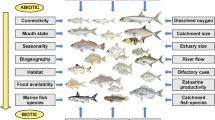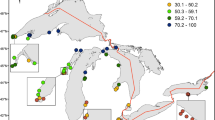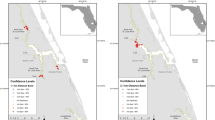Abstract
Oligohaline estuarine wetlands are found at the upper reaches of most estuaries. These wetlands are composed of several habitat types including tidal marshes, tidal creeks, and open-water areas. Twenty-five species of fish representing 11 families and three species of invertebrates were identified as economically important and abundant in oligohaline habitats along the northern Gulf and southeastern Atlantic coasts. These include anadromous and catadromous species which use low salinity habitats as migratory corridors and freshwater, estuarine and marine organisms which use these habitats as nursery and feeding areas. The few comparative data available suggest that some oligohaline wetland habitats may be of equal importance to higher salinity marshes for at least two important estuarine species (spot and Atlantic menhaden). Until detailed studies are available for specific estuaries, oligohaline habitats should be considered as valuable as salt marsh habitats. The value of these habitats as nursery areas should be considered by managers and regulatory agencies when reviewing proposals to modify them.
Similar content being viewed by others
Literature Cited
Boynton, W. R., T. T. Polgar, and H. H. Zion. 1981. Importance of juvenile striped bass food habits in the Potomac Estuary. Transactions of the American Fisheries Society 110:56–63.
Bozeman, E. L., Jr. and J. M. Dean. 1980. The abundance of estuarine larval and juvenile fish in a South Carolina intertidal creek. Estuaries 3:89–97.
Cain, R. L. and J. M. Dean. 1976. Annual occurrence, abundance and diversity of fish in a South Carolina intertidal creek. Marine Biology 36:369–379.
Chabreck, R. H. and R. G. Linscombe. 1982. Changes in vegetative types in Louisiana coastal marshes over a 10-year period. Proceedings of the Louisiana Academy of Sciences 45:98–102.
Choa, L. N. and J. A. Musick. 1977. Life history, feeding habits and functional morphology of juvenile sciaenid fishes in the York River estuary, Virginia. Fishery Bulletin 75:657–702.
Clark, S. H. 1974. A study of variation in trawl data collected in Everglades National Park, Florida. Transactions of the American Fisheries Society 103:777–785.
Conner, J. V. and F. M. Truesdale. 1973. Ecological implications of a freshwater impoundment in a low salinity marsh. Pages 259–276 in R. H. Chabreck (ed.) Proceedings Coastal Marsh and Estuary Symposium. Louisiana State Univ., Baton Rouge, LA.
Dahlberg, M. D. 1972. An ecological study of Georgia coastal fishes. Fishery Bulletin 70:323–353.
Darnell, R. M. 1959. Studies of the life history of the blue crab (Callinectes sapidus Rathbun) in Louisiana waters. Transactions of the American Fisheries Society 88:294–304.
Davis J. R. and R. B. Cheek. 1966. Distribution, food habits and growth of young clupeids, Cape Fear River system, North Carolina. Proceedings of Twentieth Annual Conference Southeast Association of Game Fish Commissioners 20:250–260.
Department of Commerce. 1970-79. North Carolina Landings. National Marine Fisheries Service. Washington, D. C.
Gunter, G. 1956. A revised list of euryhaline fishes of North and Middle America. American Midland Naturalist 56:345–354.
Gunter, G. 1957. Predominance of the young among marine fishes found in fresh water. Copeia 1957:13–16.
Gunter, G. 1967. Some relationships of estuaries to the fisheries of the Gulf of Mexco. Pages 621–638 in G. H. Lauf (ed.) Estuaries. American Association for the Advancement of Science, Washington, D. C.
Gunter, G., J. Y. Christmas, and R. Killebrew. 1964. Some relations of salinity to population distributions of motile estuarine organisms, with special reference to penaeid shrimp. Ecology 45:181–185.
Gunter, G. and W. E. Shell, Jr. 1958. A study of an estuarine area with water-level control in the Louisiana marsh. Proceedings of the Louisiana Academy of Sciences 21:5–34.
Hackney, C. T. and A. A. de la Cruz. 1981. Some notes on the macrofauna of an oligohaline tidal creek in Mississippi. Bulletin of Marine Science 31:658–661.
Hansen, D. J. 1970. Food, growth, migration, reproduction, and abundance of pinfish,Lagodon rhomboides, and Atlantic croaker,Micropogon undulatus, near Pensacola, Florida, 1963–65. Fishery Bulletin 68:135–146.
Haven, D. S. 1957. Distribution, growth and availability of juvenile croaker,Micropogon undulatus. in Virginia. Ecology 38:88–97.
Hernandez, M. E. (Project director). 1976. Environmental study of Lake Peigneur, a tidal lake. National Science Foundation Grant No. 76-07972. Univ. of Southwestern Louisiana, Lafayette, LA. 284 p.
Khlebovitch, V. V. 1969. Aspects of animal evolution related to critical salinity and internal state. Marine Biology 2:338–345.
Lewis, R. M., E. P. H. Wilkens, and H. R. Gordy. 1972. A description of young Atlantic menhaden,Brevoortia tyrannus, in the White Oak River estuary, North Carolina. Fishery Bulletin 70:115–118.
Lippson, A. J. 1973. The Chesapeake Bay in Maryland: An atlas of natural resources. John Hopkins University Press, Baltimore, Maryland. 55 p.
Lippson, A. J., M. S. Haire, A. F. Holland, F. Jacobs, J. Jensen, R. L. Moran-Johnson, T. T. Polgar, and W. A. Richkus. 1979. Environmental atlas of the Potomac Estuary. Martin Marietta Corporation, Baltimore, Maryland. 280 p.
Mansueti, R. 1960. Comparison of the movements of stocked and resident yellow perch,Perca flavescens. in tributaries of Chesapeake Bay, Maryland. Chesapeake Science 1:21–35.
Mansueti, R. 1961. Movements, reproduction, and mortality of the white perch,Roccus americanus, in the Patuxent estuary, Maryland. Chesapeake Science 2:142–205.
Markle, D. F. 1976. The seasonality of availability and movements of fishes in the channel of the York River, Virginia. Chesapeake Science 17:50–55.
Massmann, W. H. 1954. Marine fishes in fresh and brackish waters of Virginia rivers. Ecology 35:75–78.
McHugh, J. L. 1966. Management of estuarine fisheries. Pages 133–154 in A Symposium on Estuarine Fisheries, American Fisheries Society, Special Publication 3.
McHugh, J. L. 1981. Marine fishes of Delaware. Fishery Bulletin 79:575–599.
Merriner J. V., W. H. Kriete, and C. C. Grant. 1976. Seasonality, abundance and diversity of fishes in the Piankatank River, Virginia (1970–1971). Chesapeake Science 17:238–245.
Miglarese, J. V., C. W. McMillan, and M. H. Shealy, Jr. 1982. Seasonal abundance of Atlantic croaker (Micropogonias undulatus) in relation to bottom salinity and temperature in South Carolina estuaries. Estuaries 5:216–223.
Miller, R. E., S. D. Sulkin, and R. L. Lippson. 1975. Composition and seasonal abundance of the blue crab,Callinectes sapidus Rathbun, in the Chesapeake and Delaware Canal and adjacent waters. Chesapeake Science 16:27–31.
Morris, A. W., R. C. Mantoura, A. J. Bale, and R. J. M. Howland. 1978. Very low salinity regions of estuaries: important sites for chemical and biological reactions. Nature 274:678–680.
Nelson W. R. 1969. Studies on the croaker,Micropogon undulatus Linnaeus, and the spot,Leiostomus xanthurus Lacepede, in Mobile Bay, Alabama. Journal of Marine Science Alabama 1:4–92.
Pacheco, A. L. 1962. Age and growth of spot in lower Chesapeake Bay with notes on distribution and abundance of juveniles in the York River system. Chesapeake Science 3:18–28.
Powell, A. B. and F. J. Schwartz. 1977. Distribution of paralichthid flounders (Bothidae: Paralichthys) in North Carolina Estuaries. Chesapeake Science 18:334–339.
Raney, E. C. and W. H. Massmann. 1953. The fishes of the tidewater section of the Pamunkey River, Virginia. Journal of the Washington Academy of Science 43:424–432.
Remane, A. and C. Schlieper. 1971. Biology of Brackish Water. John Wiley and Sons, New York, 372 p.
Rogers, S. G., T. E. Targett, and S. B. Van Sant. 1984. Fish-nursery use in Georgia salt marsh estuaries: the influence of springtime freshwater conditions. Transactions of the American Fisheries Society 113:595–606.
Rounsefell, G. A. 1964. Preconstruction study of the fisheries of the estuarine areas traversed by the Mississippi River-Gulf Outlet Project. Fishery Bulletin 63:373–393.
Rozas, L. P. 1982. Utilization of oligohaline intertidal rivulets by fishes and macrofaunal crustaceans in the Cape Fear River Estuary, North Carolina. M. S. Thesis. Univ. of North Carolina at Wilmington, Wilmington, NC. 74 p.
Rozas, L. P. and C. T. Hackney. 1984. Use of oligohaline marshes by fishes and macrofaunal crustaceans in North Carolina. Estuaries 7:213–224.
Setzler-Hamilton, E. M., W. R. Boynton, J. A. Milhursky, T. T. Polgar, and K. V. Wood. 1981. Spatial and temporal distribution of striped bass eggs, larvae and juveniles in the Potomac Estuary. Transactions of the American Fisheries Society 110:121–136.
Shenker, J. M. and J. M. Dean. 1979. The utilization of an intertidal salt marsh creek by larval and juvenile fishes: abundance, diversity and temporal variation. Estuaries 2:154–163.
Subrahmanyam, C. B. and S. H. Drake. 1975. Studies on the animal communities in two north Florida salt marshes: I. Fish communities. Bulletin of Marine Science 25:445–465.
Tagatz, M. E. 1968. Biology of the blue crab.Callinectes sapidus Rathbun, in the St. Johns River, Florida. Fishery Bulletin 67:17–33.
Tagatz, M. E. and D. L. Dudley. 1961. Seasonal occurrence of marine fishes in four shore habitats near Beaufort, N. C., 1957–1960, U. S. Fish and Wildlife Service, Special Scientific Reports. Fisheries 390. 19 p.
Tebo, L. B., Jr. and E. G. McCoy. 1964. Effect of sea-water concentrations on the reproduction and survival of largemouth bass and bluegills. Progressive Fish-Culturist 26:99–106.
Weinstein, M. P. 1979. Shallow marsh habitats as primary nurseries for fishes and shellfish, Cape Fear River, North Carolina. Fishery Bulletin 77:339–357.
Wilkens, E. P. H. and R. M. Lewis. 1971. Abundance and distribution of young Atlantic menhaden,Brevoortia tyrannus, in the White Oak River estuary, North Carolina. Fishery Bulletin 69:783–790.
Author information
Authors and Affiliations
Rights and permissions
About this article
Cite this article
Rozas, L.P., Hackney, C.T. The importance of oligohaline estuarine wetland habitats to fisheries resources. Wetlands 3, 77–89 (1983). https://doi.org/10.1007/BF03160732
Issue Date:
DOI: https://doi.org/10.1007/BF03160732




